
In graph theory, a circulant graph is an undirected graph acted on by a cyclic group of symmetries which takes any vertex to any other vertex. It is sometimes called a cyclic graph, [1] but this term has other meanings.

In graph theory, a circulant graph is an undirected graph acted on by a cyclic group of symmetries which takes any vertex to any other vertex. It is sometimes called a cyclic graph, [1] but this term has other meanings.
Circulant graphs can be described in several equivalent ways: [2]
Every cycle graph is a circulant graph, as is every crown graph with 2 modulo 4 vertices.
The Paley graphs of order n (where n is a prime number congruent to 1 modulo 4) is a graph in which the vertices are the numbers from 0 to n− 1 and two vertices are adjacent if their difference is a quadratic residue modulo n. Since the presence or absence of an edge depends only on the difference modulo n of two vertex numbers, any Paley graph is a circulant graph.
Every Möbius ladder is a circulant graph, as is every complete graph. A complete bipartite graph is a circulant graph if it has the same number of vertices on both sides of its bipartition.
If two numbers m and n are relatively prime, then the m×n rook's graph (a graph that has a vertex for each square of an m×n chessboard and an edge for each two squares that a chess rook can move between in a single move) is a circulant graph. This is because its symmetries include as a subgroup the cyclic group Cmn Cm×Cn. More generally, in this case, the tensor product of graphs between any m- and n-vertex circulants is itself a circulant. [2]
Many of the known lower bounds on Ramsey numbers come from examples of circulant graphs that have small maximum cliques and small maximum independent sets. [1]
The circulant graph with jumps is defined as the graph with nodes labeled where each node i is adjacent to 2k nodes .
A self-complementary graph is a graph in which replacing every edge by a non-edge and vice versa produces an isomorphic graph. For instance, a five-vertex cycle graph is self-complementary, and is also a circulant graph. More generally every Paley graph of prime order is a self-complementary circulant graph. [4] Horst Sachs showed that, if a number n has the property that every prime factor of n is congruent to 1 modulo 4, then there exists a self-complementary circulant with n vertices. He conjectured that this condition is also necessary: that no other values of n allow a self-complementary circulant to exist. [2] [4] The conjecture was proven some 40 years later, by Vilfred. [2]
Define a circulant numbering of a circulant graph to be a labeling of the vertices of the graph by the numbers from 0 to n− 1 in such a way that, if some two vertices numbered x and y are adjacent, then every two vertices numbered z and (z−x + y) mod n are adjacent. Equivalently, a circulant numbering is a numbering of the vertices for which the adjacency matrix of the graph is a circulant matrix.
Let a be an integer that is relatively prime to n, and let b be any integer. Then the linear function that takes a number x to ax + b transforms a circulant numbering to another circulant numbering. András Ádám conjectured that these linear maps are the only ways of renumbering a circulant graph while preserving the circulant property: that is, if G and H are isomorphic circulant graphs, with different numberings, then there is a linear map that transforms the numbering for G into the numbering for H. However, Ádám's conjecture is now known to be false. A counterexample is given by graphs G and H with 16 vertices each; a vertex x in G is connected to the six neighbors x ± 1, x ± 2, and x ± 7 modulo 16, while in H the six neighbors are x ± 2, x ± 3, and x ± 5 modulo 16. These two graphs are isomorphic, but their isomorphism cannot be realized by a linear map. [2]
Toida's conjecture refines Ádám's conjecture by considering only a special class of circulant graphs, in which all of the differences between adjacent graph vertices are relatively prime to the number of vertices. According to this refined conjecture, these special circulant graphs should have the property that all of their symmetries come from symmetries of the underlying additive group of numbers modulo n. It was proven by two groups in 2001 and 2002. [5] [6]
There is a polynomial-time recognition algorithm for circulant graphs, and the isomorphism problem for circulant graphs can be solved in polynomial time. [7] [8]

In group theory, a branch of abstract algebra, a cyclic group or monogenous group is a group that is generated by a single element. That is, it is a set of invertible elements with a single associative binary operation, and it contains an element g such that every other element of the group may be obtained by repeatedly applying the group operation to g or its inverse. Each element can be written as a power of g in multiplicative notation, or as a multiple of g in additive notation. This element g is called a generator of the group.
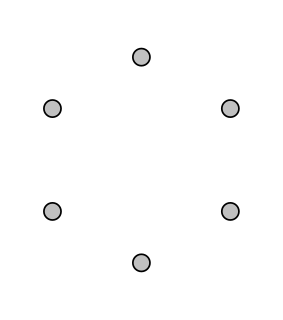
In graph theory, a regular graph is a graph where each vertex has the same number of neighbors; i.e. every vertex has the same degree or valency. A regular directed graph must also satisfy the stronger condition that the indegree and outdegree of each vertex are equal to each other. A regular graph with vertices of degree k is called a k‑regular graph or regular graph of degree k. Also, from the handshaking lemma, a regular graph of odd degree will contain an even number of vertices.

In the mathematical field of graph theory, the Petersen graph is an undirected graph with 10 vertices and 15 edges. It is a small graph that serves as a useful example and counterexample for many problems in graph theory. The Petersen graph is named after Julius Petersen, who in 1898 constructed it to be the smallest bridgeless cubic graph with no three-edge-coloring.
In the mathematical discipline of graph theory, the line graph of an undirected graph G is another graph L(G) that represents the adjacencies between edges of G. L(G) is constructed in the following way: for each edge in G, make a vertex in L(G); for every two edges in G that have a vertex in common, make an edge between their corresponding vertices in L(G).
In the mathematical discipline of graph theory, a graph labelling is the assignment of labels, traditionally represented by integers, to edges and/or vertices of a graph.

In mathematics, Paley graphs are dense undirected graphs constructed from the members of a suitable finite field by connecting pairs of elements that differ by a quadratic residue. The Paley graphs form an infinite family of conference graphs, which yield an infinite family of symmetric conference matrices. Paley graphs allow graph-theoretic tools to be applied to the number theory of quadratic residues, and have interesting properties that make them useful in graph theory more generally.

In graph theory, a rook's graph is a graph that represents all legal moves of the rook chess piece on a chessboard. Each vertex of a rook's graph represents a square on a chessboard, and each edge represents a legal move from one square to another. The same graphs can be defined mathematically as the Cartesian products of two complete graphs or as the line graphs of complete bipartite graphs.

In the mathematical area of graph theory, a triangle-free graph is an undirected graph in which no three vertices form a triangle of edges. Triangle-free graphs may be equivalently defined as graphs with clique number ≤ 2, graphs with girth ≥ 4, graphs with no induced 3-cycle, or locally independent graphs.
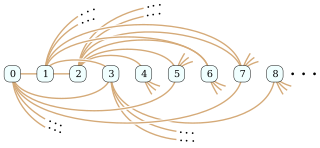
In the mathematical field of graph theory, the Rado graph, Erdős–Rényi graph, or random graph is a countably infinite graph that can be constructed by choosing independently at random for each pair of its vertices whether to connect the vertices by an edge. The names of this graph honor Richard Rado, Paul Erdős, and Alfréd Rényi, mathematicians who studied it in the early 1960s; it appears even earlier in the work of Wilhelm Ackermann (1937). The Rado graph can also be constructed non-randomly, by symmetrizing the membership relation of the hereditarily finite sets, by applying the BIT predicate to the binary representations of the natural numbers, or as an infinite Paley graph that has edges connecting pairs of prime numbers congruent to 1 mod 4 that are quadratic residues modulo each other.
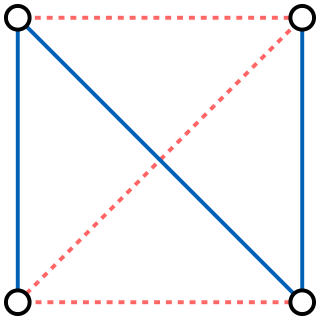
A self-complementary graph is a graph which is isomorphic to its complement. The simplest non-trivial self-complementary graphs are the 4-vertex path graph and the 5-vertex cycle graph.
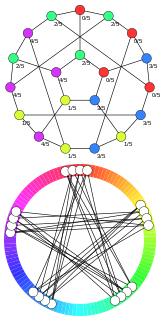
In graph theory, circular coloring may be viewed as a refinement of usual graph coloring. The circular chromatic number of a graph , denoted can be given by any of the following definitions, all of which are equivalent.

In combinatorial mathematics, the ménage problem or problème des ménages asks for the number of different ways in which it is possible to seat a set of male-female couples at a round dining table so that men and women alternate and nobody sits next to his or her partner. This problem was formulated in 1891 by Édouard Lucas and independently, a few years earlier, by Peter Guthrie Tait in connection with knot theory. For a number of couples equal to 3, 4, 5, ... the number of seating arrangements is
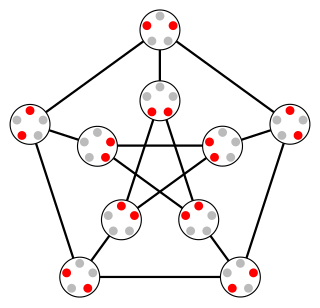
In the mathematical field of graph theory, the odd graphsOn are a family of symmetric graphs with high odd girth, defined from certain set systems. They include and generalize the Petersen graph.

In graph theory, Grinberg's theorem is a necessary condition for a planar graph to contain a Hamiltonian cycle, based on the lengths of its face cycles. The result has been widely used to construct non-Hamiltonian planar graphs with further properties, such as to give new counterexamples to Tait's conjecture. This theorem was proved by Latvian mathematician Emanuel Grinberg in 1968.

In graph theory, the generalized Petersen graphs are a family of cubic graphs formed by connecting the vertices of a regular polygon to the corresponding vertices of a star polygon. They include the Petersen graph and generalize one of the ways of constructing the Petersen graph. The generalized Petersen graph family was introduced in 1950 by H. S. M. Coxeter and was given its name in 1969 by Mark Watkins.
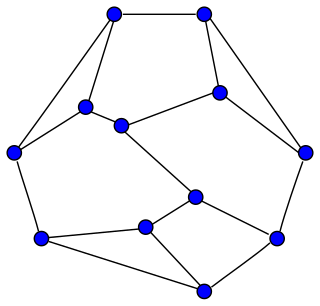
Frucht's theorem is a theorem in algebraic graph theory conjectured by Dénes Kőnig in 1936 and proved by Robert Frucht in 1939. It states that every finite group is the group of symmetries of a finite undirected graph. More strongly, for any finite group G there exist infinitely many non-isomorphic simple connected graphs such that the automorphism group of each of them is isomorphic to G.
In combinatorial mathematics, Toida's conjecture, due to Shunichi Toida in 1977, is a refinement of the disproven Ádám's conjecture from 1967.
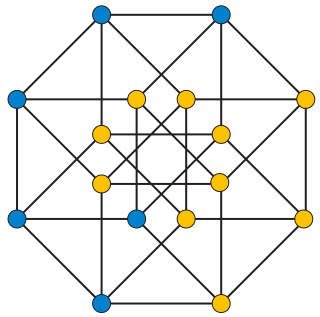
In graph theory, a distinguishing coloring or distinguishing labeling of a graph is an assignment of colors or labels to the vertices of the graph that destroys all of the nontrivial symmetries of the graph. The coloring does not need to be a proper coloring: adjacent vertices are allowed to be given the same color. For the colored graph, there should not exist any one-to-one mapping of the vertices to themselves that preserves both adjacency and coloring. The minimum number of colors in a distinguishing coloring is called the distinguishing number of the graph.
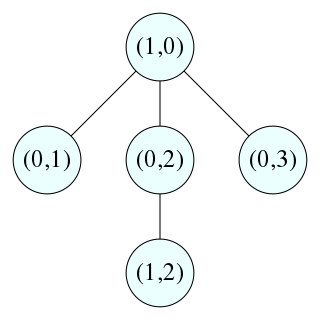
In mathematics, and more specifically in combinatorial commutative algebra, a zero-divisor graph is an undirected graph representing the zero divisors of a commutative ring. It has elements of the ring as its vertices, and pairs of elements whose product is zero as its edges.

In graph theory, a locally linear graph is an undirected graph in which the neighborhood of every vertex is an induced matching. That is, for every vertex , every neighbor of should be adjacent to exactly one other neighbor of . Equivalently, every edge of such a graph belongs to a unique triangle . Locally linear graphs have also been called locally matched graphs.